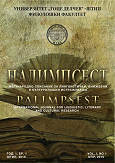ИНТЕРАКТИВНИОТ ДИСКУРС ВО ГРАМАТИКИТЕ НА КОНЕСКИ И НА ЛАНТ: ВКЛУЧУВАЊЕ НА ЧИТАТЕЛИТЕ
INTERACTIVE DISCOURSE IN KONESKI’S AND LUNT’S GRAMMARS: READER ENGAGEMENT
Author(s): Fevzudina Saračević, Liljana MitkovskaSubject(s): Language studies, Language and Literature Studies, Historical Linguistics, Comparative Linguistics, Phraseology
Published by: Универзитет »Гоце Делчев« - Штип
Keywords: academic writing; discourse analysis; interaction; inclusive we.
Summary/Abstract: In this study we compare at discourse level two grammars of the Macedonian language: one by Blaže Koneski (1952, 1967), written in Macedonian, and the other by Horace Lunt (1952), written in English. We focus on personal reference and how readers are introduced and guided through the material in the two texts. We examine the predicates (and pronouns) which imply collectivity (including the author and the audience) compared to those that convey the author’s voice and those that bring third persons into the discussion in order to determine their frequency, form and range of function in the two texts. The main aim is to examine how the authors engage the potential readers and interact with them. For the analysis, we use Hyland’s model for interaction in academic discourse (Hyland, 2005), which we adapt to the Macedonian language. The first observations suggest that Koneski’s text is more interactive than Lunt’s, which follows the tradition of more objective expression. Detailed analysis will tell us which features of the discourse are characteristic of the authors and how they reflect the practise of scholarly style at the time.
Journal: Палимпсест, Меѓународно списание за лингвистички, книжевни и културолошки истражувања
- Issue Year: 8/2023
- Issue No: 15
- Page Range: 15-26
- Page Count: 11
- Language: Macedonian

